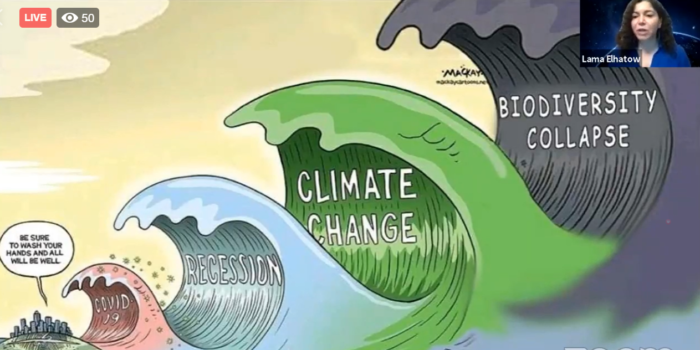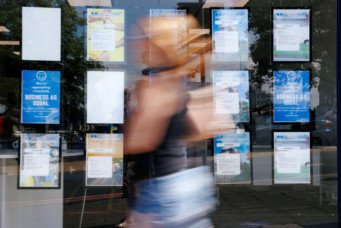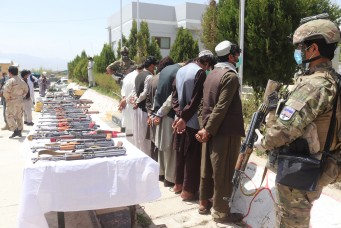Climate Change and COVID-19: There Is More Than One Curve to Flatten
What COVID-19 response can tell us about our readiness to deal with climate change

Photos of cleaner and clearer waters of the Venice canals circulated on social media during the early days of the COVID-19 global pandemic. The BBC said this was due to the COVID-19 lockdown, a halt to tourism and hence a drop in traffic in the city. For the first time in years, fish could be seen through the water. Similar incidents of receding pollution and environmental improvement were sighted in the rest of the world.
Lama El-Hatow, an environmental and social consultant at the International Finance Corporation (IFC), an international financial institution and member of the World Bank Group, believes that being forced to stay at home has had an overall positive impact on the environment, but how the world chooses to return to normal will determine what comes next. During her online talk hosted by Alternative Policy Solutions, a public policy research project at the American University in Cairo, El-Hatow showed an illustration where future crises were represented in tsunami waves, each bigger than the one before it. She explained that once COVID-19 (the first wave) comes to an end, economic recession, climate change, and biodiversity collapse will follow.
“We all ask when this disaster will end and how, but we need to keep in mind that there are a lot of other bigger crises that will follow,” El-Hatow said.
As a result, COVID-19 and climate change cannot be handled separately. Essentially, if COVID-19 and climate change issues are solved separately, when the virus ends, climate change repercussions will be much harsher than before, and new viruses will continue to emerge. This is particularly critical when one considers that the coronavirus itself came from nature. Research studies have shown that the virus moved from animals to humans in Wuhan, China’s wet markets. “Infectious diseases that cause epidemics are often a result of things people do in nature. The disruption of nature causes disease and 60 percent of these infectious diseases are zoonotic; meaning they come from animals first. This includes AIDS, Ebola, swine flu, and mad cow disease,” she said.
The destruction of ecosystems is the starting point and the reason why these diseases are transferred from animals to humans. Deforestation, for example, destroys natural animal habitats forcing animal migration to other locations where they may come into direct contact with large human populations for the first time, or captivity where they are sold in wet markets thus causing an imbalance to the ecosystem. There is then a direct correlation between the loss of habitats and an increase in human diseases. For instance, El-Hatow explained that a 4 percent deforestation in the Amazon rainforest would cause a 50 percent increase in malaria.
The Unintentional Benefits of How COVID-19 Was Handled
The global response to COVID-19 may indicate how we should deal with climate change. The past few months have shown that lockdown, quarantine, travel bans, work from home, social distancing, online learning, and reduced transportation were not only able to directly curb the spread of the virus, but also had a positive impact on the environment. Global emissions were also briefly reduced.
Inevitably, however, there was economic disruption as unemployment skyrocketed and global supply chains were affected, explained El-Hatow.
The World Bank where El-Hatow works traditionally holds an annual meeting of some 10 thousand people but because it was done virtually this year, there was a reduction of 79, 500 metric tons of carbon dioxide emissions. She noted that the quantities of such emissions are equivalent to those produced from the deforestation of large areas of the Hawaiian Islands.
But whether or not the impact of this is only short term is still a question on the table.
While consumer spending did decrease on a whole, it also shifted to new markets. “We are consumption-driven societies, and this increases climate change issues. But when we were on lockdown for three months, consumption decreased in certain areas, for example in luxury goods, but caused an increase in food and medical supplies,” El-Hatow said.
When life returns to normal, higher consumption rates, pollution, and deforestation will come back and perhaps with harsher impact, explained El-Hatow. In China, when shops reopened, for instance, Hermès sold luxury goods for about 3 million dollars. “This is what revenge purchasing looks like. When shops reopen, there are queues of people shopping again.”
This is why returning to “normal” needs to be accompanied with new perspectives based on the lessons learned from COVID-19. When lockdowns were first implemented, businesses and entrepreneurs had to think outside the box with online learning, online working, and remote entertainment, meaning that “business as usual” may never look the same. “We’ll still have to somehow return to normal but it needs to be done in a way that won’t hurt, or increase carbon emissions to worse levels.”
What Should Recovery Look Like?
As people have relatively adapted to life online, there are golden opportunities to be taken. When asked how the world should embrace the digital transition for the sake of the environment, El-Hatow said that people’s behavior is key. “As individuals, we need awareness and to know that what we do, what we consume, and how much we consume, impacts the world. The private sector needs to encourage digital work for remote learning, remote education, remote shopping and remote entertainment,” El-Hatow told the Cairo Review.
But a lot of this is easier said than done, especially with the social disparities that exist in every society and a virus that has left the world in economic decline. El-Hatow stressed that people in lower income households have less internet access than those in richer households and countries. Although there are those who may be able to work from home, many receive daily income salaries and work in the informal economy, which makes them even more vulnerable to climate change and health hazards. The economic downturn caused by COVID-19, according to the World Bank, is predicted to shrink the global economy by 5.2 percent this year—the deepest recession since the second World War.
El-Hatow explained that governments need to work together to flatten both climate change and COVID-19 curves. Creating a balance between the economy and development, and the health of humans and the planet is essential, she said. It is necessary for countries to work together for better long-term results. “For post COVID-19 recovery, there needs to be social inclusion in terms of health care and education infrastructure, investments in renewable energy, and a move to a more digital economy that includes e-commerce, e-payments, e-learning and e-governance.”
At least from the shared experience of COVID-19, global communities have learned about solidarity on the individual, national, and global levels, and have gained some awareness that human behavior does indeed have an impact on our carbon footprint.
Dania El Akkawi is associate editor at the Cairo Review of Global Affairs.
Read More



